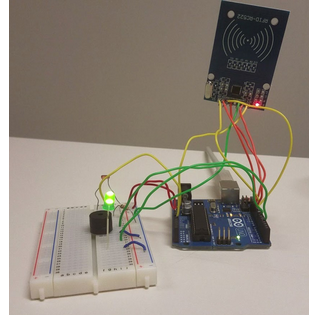Anti-Theft Backpack
Why an Anti-Theft Backpack?
 During the Fall 2018 semester, Kelsey Fukushima, Taylor Inong, and I designed and created a device which protects a backpack from pick pocketing by sensing when the bag is opened without permission and alerting the wearer with an alarm.
During the Fall 2018 semester, Kelsey Fukushima, Taylor Inong, and I designed and created a device which protects a backpack from pick pocketing by sensing when the bag is opened without permission and alerting the wearer with an alarm.
Right off the bat we wanted to create a project that incorporated fashion in some way because it was something we were interested in, as well as something we believed could set us apart from previous projects. While wearables that light up and make sound (such as holiday themed or rave clothing) are really cool, we wanted to create something that also had a practical use. Lights and sound are a form of non-verbal communication that can be used to inform the user. What was a problem that generated input that justified the need for lights and sound as output? We came up with the idea of making a device that acted similarly to a car alarm, for a backpack. The device would alert the owner that the object was being handled in an unauthorized way by emitting an alarm. Car alarms usually have a key that enables and disables the lock mechanism. After researching multiple option, we decided to use an RFID card for this purpose.
Image Credit: Arduino Website and Arduino Logo
What did I do?
 Over the course of the semester, we met weekly; we all relied on each other for different components of the project. I contributed to this project by researching information on existing anti-theft technologies and RFID capabilities, as well as handpicking the backpack and plastic casing used in the final design. My most meaningful additions were to plan and write a portion of the input sensing and output LED code, and to script, record, and edit footage to create the video summary of the project.
Over the course of the semester, we met weekly; we all relied on each other for different components of the project. I contributed to this project by researching information on existing anti-theft technologies and RFID capabilities, as well as handpicking the backpack and plastic casing used in the final design. My most meaningful additions were to plan and write a portion of the input sensing and output LED code, and to script, record, and edit footage to create the video summary of the project.
What did I learn?
 Because of this project, I was introduced to technologies that I have never directly worked with before: Arduino hardware and RFID technology, and the Arduino IDE. It was inspiring to be able to create a functional product without much technical knowledge; it goes to show what can happen with creativity and determination. Additionally, this project changed my perspective on how I interact with the world; I started to notice how my actions were being trained by different feedback, like how the button on a vending machine lights up after I press it. I began look for things that I could incorporate into our device. In the future we may incorporate different multicolor LEDs; we may use a red LED to show the incorrect key was used, and a green LED to show that the correct key was used. Alternatively, we could use an LCD screen to show more detailed information.
Because of this project, I was introduced to technologies that I have never directly worked with before: Arduino hardware and RFID technology, and the Arduino IDE. It was inspiring to be able to create a functional product without much technical knowledge; it goes to show what can happen with creativity and determination. Additionally, this project changed my perspective on how I interact with the world; I started to notice how my actions were being trained by different feedback, like how the button on a vending machine lights up after I press it. I began look for things that I could incorporate into our device. In the future we may incorporate different multicolor LEDs; we may use a red LED to show the incorrect key was used, and a green LED to show that the correct key was used. Alternatively, we could use an LCD screen to show more detailed information.
You can watch our video on Youtube.
 During the Fall 2018 semester, Kelsey Fukushima, Taylor Inong, and I designed and created a device which protects a backpack from pick pocketing by sensing when the bag is opened without permission and alerting the wearer with an alarm.
During the Fall 2018 semester, Kelsey Fukushima, Taylor Inong, and I designed and created a device which protects a backpack from pick pocketing by sensing when the bag is opened without permission and alerting the wearer with an alarm.
